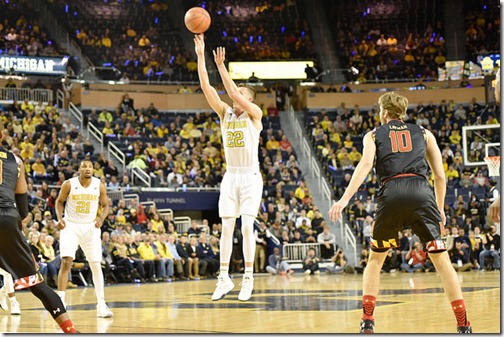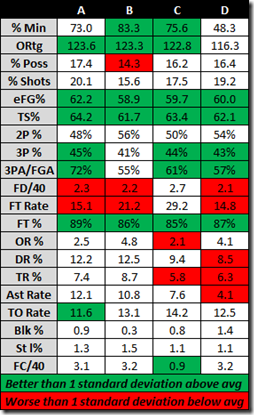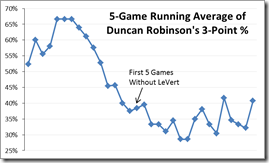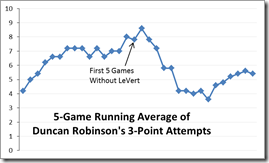Fuller
Previously: Zak Irvin, Muhammad-Ali Abdur-Rahkman
Each of these statistical profiles are some of John Beilein’s best #shooters at Michigan:
You’d probably agree that player “A” has the best numbers – though, all things considered, the profiles are very, very close. They don’t take everything into account and it’s hard to quantify many things that help basketball teams win. But based on these blind profiles (all of which are very similar), player “A” is arguably the best of the four.
The players?
A: Duncan Robinson (So., 2016)
B: Zack Novak (Sr., 2012)
C: Nik Stauskas (Fr., 2013)
D: Aubrey Dawkins (Fr., 2015)
As a senior, Novak was a far better defender than Robinson (despite his size) and a key role player on a Big Ten championship team. Stauskas blew up as a sophomore after playing a complementary role as a freshman. Dawkins had a pretty strict shooter’s profile but was a good one after becoming a freshman starter in Big Ten play. Those three player-seasons are some of Robinson’s very closest statistical comparables.
For a player in his first season at the high-major level, Duncan played well as a starter – even though his three-point percentage dropped off considerably from early-season highs, he was a tremendous floor-spacing asset. He was Michigan’s most efficient player. He finished the season with 95 made threes, third-best in Michigan history (and the best for a player under Beilein). A knockdown shooter in a well-spaced offense is invaluable, and Robinson is slotted into that role for the next two seasons.
[Hit the JUMP for the rest of the review]
It soon became evident that Robinson would fill the long-range marksman role for Michigan’s offense, and he did it well. Preseason hype deemed him Stauskasesque, and, if anything, Duncan exceeded those expectations early. He quickly gained a starting spot and key rotation minutes, and – with a 6’8" frame, a quick release, and a great high-volume three-point shooting percentage – he was an important asset, complementing Michigan’s creators. If it seems like he was rather one dimensional, it’s because he was:
While Robinson did show an ability to attack closeouts, he rarely did so and took almost three-quarters of his shots from behind the three-point line. Similarly, though he did have a modest assist rate (mostly from setting up big men with wide-open looks after the defense focused too much on him), he mostly took shots set up by others instead. It’s easy to quantify shooting, and Duncan was about as good as they come. 45% – which finished 26th nationally among qualifying players – on over 200 attempts is production that the coaches would have gladly taken, if offered before the season.
Of course, there are other, less well-developed parts of Robinson’s game that merit attention. Despite his size and length on the wing, he was a poor defender – although it’s worth noting that he was evidently better enough than Aubrey Dawkins to warrant getting about four times as many minutes as Dawkins did during postseason play, even though Aubrey had actually been shooting far better from three over the last couple months.
Still, Robinson was often a culprit in Michigan’s many defensive breakdowns. Eventually, he became better at contesting shots and battling on the defensive glass, but his defensive rotations and general awareness on that end – like everyone else – was lacking. After the season, Beilein emphasized the (obvious) need for defensive improvement, especially in one-on-one situations, and after a season of seeing many players – including Robinson – get routinely blown by on dribble drives, it’s clear that he needs to put in work on that end of the floor.
* * *
As Michigan’s season wore on, Duncan became less effective as a shooter. While the loss of Caris LeVert surely played a role in that (as he was one of the top distributors in college basketball, and drew far more attention from the defense than either Zak Irvin or Derrick Walton), the increased scouting rigor of Big Ten play and the cumulative fatigue of playing his first season at this level also played a part. His three-point percentage flagged down the stretch for a variety of factors, but the drop-off in his attempts per game is also a concern.
Once LeVert went down, Robinson became the primary focus for several opposing defenses. For example, Purdue was often content to lock Rapheal Davis – a former Big Ten Defensive POY – onto Robinson and avoid having him give help, letting Michigan effectively play four-on-four offense with those two out of the picture. With a player like Robinson, getting him to a certain number of quality attempts is critical. The other Wolverines often did well to look for him, first and foremost, in situations where the defense might be scrambled – for example, Walton built up some chemistry with Robinson on little pitches behind him to Duncan on the wing when he was trailing in transition. Once defenses made him their primary focus in the half court though, he was frequently unable to free himself for quality looks. As the graph above indicates, his attempts per game saw as precipitous a decline as his percentage did. When those two graphs are combined…
…the impact of both become pretty clear. Because Michigan didn’t have an adequate replacement for Robinson, he usually played around at least thirty minutes per game, no matter what, but there’s no way that his presence on the court was a net positive if he was only making about one three-pointer per game. Inserting Dawkins (which will no longer be an option, obviously) to hit a few threes wasn’t ever the solution, because he was sure to give back as many or more open looks on the other end. Instead, Michigan was often forced to ride it out with Robinson, even if he wasn’t in a groove offensively. It’s hard to overstate the role that this dynamic played in Michigan’s late-season struggles to generate offense. Though the reductive “live or die by the three” axiom didn’t fit the Wolverines, Duncan’s ability to chip in a quick scoring burst was huge in games when Michigan was successful.
* * *
After taking a mandatory redshirt season, Robinson was an integral part of the rotation this past season – and his role was very clear. While his torrid shooting from early on couldn’t be sustained over the course of the whole campaign, he was still one of the deadliest shooters in the Big Ten – certainly Michigan’s best. Duncan could score the ball more efficiently than anyone else, and a possession that resulted in him taking a three-pointer was a good one, regardless of the outcome. Hopefully, the late-season struggles to get his shot and convert when he did will be a learning experience for him moving forward.
The following players have two seasons of eligibility left: Robinson, Muhammad-Ali Abdur-Rahkman, and Kam Chatman. Unfortunately, Michigan looks to be shallow at the three and four yet again as Dawkins transferred out without a replacement, but at least Duncan projects to hold down a starting spot for another two seasons. While his upside is clearly much lower than Stauskas’s was, he had the same type of impact in his first year in the program and has become a known quantity – at the very least, he’s a terrific shooter. Improvement to an All-Big Ten level of play is contingent on the development of other parts of his game, but with the way Michigan’s roster is currently composed, he’s a sorely-needed sniper in the corner. That certainly won’t change.





